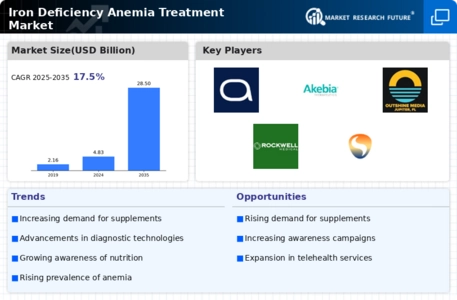Rising Healthcare Expenditure
The upward trend in healthcare expenditure is a significant driver for the Iron Deficiency Anemia Treatment Market. As countries allocate more resources to healthcare, there is a corresponding increase in spending on anemia treatments, including iron supplements and therapies. This trend is particularly evident in emerging economies, where improving healthcare infrastructure and access to medications is a priority. Increased investment in healthcare not only enhances the availability of treatment options but also fosters innovation in the development of new therapies. Consequently, this rise in healthcare expenditure is expected to positively impact the market, as more individuals gain access to necessary treatments for iron deficiency anemia.
Government Initiatives and Support
Government initiatives aimed at combating iron deficiency anemia are playing a crucial role in shaping the Iron Deficiency Anemia Treatment Market. Various health organizations and governments are implementing programs to raise awareness, improve screening, and provide access to iron supplements, particularly in vulnerable populations. For instance, initiatives targeting pregnant women and children have been established to reduce the prevalence of anemia. Such programs not only facilitate early diagnosis and treatment but also encourage research and development in the field. As these initiatives gain momentum, they are likely to stimulate market growth by increasing the availability and accessibility of treatment options.
Advancements in Treatment Modalities
Innovations in treatment modalities are significantly influencing the Iron Deficiency Anemia Treatment Market. The development of new iron formulations, including intravenous iron therapies and oral supplements with improved bioavailability, has expanded the options available for patients. These advancements not only enhance the efficacy of treatment but also reduce side effects, thereby improving patient compliance. Furthermore, the introduction of combination therapies that address underlying causes of anemia, such as chronic diseases, is gaining traction. As healthcare professionals adopt these novel approaches, the market is expected to experience growth, driven by the demand for more effective and patient-friendly treatment solutions.
Growing Focus on Preventive Healthcare
The shift towards preventive healthcare is emerging as a key driver for the Iron Deficiency Anemia Treatment Market. As healthcare systems worldwide emphasize prevention over treatment, there is a growing recognition of the importance of addressing iron deficiency before it leads to anemia. This proactive approach includes routine screening, dietary education, and supplementation programs aimed at-risk populations. By prioritizing prevention, healthcare providers can reduce the incidence of iron deficiency anemia, thereby influencing market dynamics. This trend is likely to foster a more comprehensive approach to anemia management, ultimately driving demand for preventive treatments and interventions.
Increasing Prevalence of Iron Deficiency Anemia
The rising incidence of iron deficiency anemia is a pivotal driver for the Iron Deficiency Anemia Treatment Market. Recent estimates indicate that approximately 1.62 billion people are affected by anemia worldwide, with iron deficiency being the most common cause. This condition is particularly prevalent among women of reproductive age and children, leading to a heightened demand for effective treatment options. As awareness of the health implications associated with iron deficiency grows, healthcare providers are increasingly focusing on diagnosis and management strategies. Consequently, this trend is likely to propel the market forward, as more individuals seek treatment to mitigate the adverse effects of anemia on their health and quality of life.


















Leave a Comment